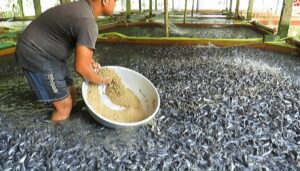How to start a fish farm | How to Start a Fish Farming | How to start a fish farming business Have you ever thought about where restaurants and supermarkets get their fish? It’s not all from operations like what you see on Deadliest Catch. Over the last 30 years, fish farming — or aquaculture — has taken over a huge portion of the market. Today, 50% of the fish sold for consumption in the United States comes from fish farms — and Americans are eating more fish than ever. Per capita, we’re consuming more than twice as much as people did 60 years ago.

With a growing population, aquaculture is more important than ever, and almost anyone can become a fish farmer with a little know-how and startup capital. This flexible business can begin on a small scale in a backyard and expand into a large, commercial fish farming operation once you have a steady stream of buyers. If you’re ready to jump in, this guide will teach you the basics of How to start a fish farm | How to Start a Fish Farming | How to start a fish farming business
What is fish farming?

Basically fish farming is also called pisciculture (fish farming) and in common language it is called fish farming, although fish farming is done in sea, rivers or ponds but it can be done commercially in tanks on your land. can do.
The fish farming done in the tanks is called Biofloc Fish Farming.
Due to the increase in the demand for fish as food in the country and the world, the demand for fish production has also increased, in such a way that artificial fish farms and rearing have been encouraged.
Man-made ponds or tanks are becoming very popular for fish farming, this type of fisheries is called aquaculture.
Read also: How to earn money from sharechat | How to earn money in share chat app
Benefits of Fish farming

- At least 60% of people consume fish as food.
- Its demand is high in the market so you get higher price which is a good source of income.
- Fish farming is not difficult, you can do it by making artificial pond.
- If you do not have space to make a pond, then you can do it in tanks, which takes less space and you can also do it on the roof of the house.
- There are abundant water resources available in the world, due to which there is no shortage of water.
- There is no need of laborers in this, you can look after yourself or the members of the household.
- It can also be done as an additional business with business like Poultry Farm, Goat Farm, Dairy Farm.
- Doing it with farming can become a source of extra income for you without any hard work.
Read also: How to create account in freelancer.com | How to open an account on Freelancer
How to start a fish farm | How to start a fish farming business
1. Select the type of fish farming
The first thing you need to consider when starting a fish farm is the type of fish that you are going to use for farming. Selecting the right species of fish plays an important role in the success of the fish farming business. The decision should be based on a maintenance point of view, market demand, management outlook, and availability of resources, etc. Some of the popular fish farming business ideas which give good returns are given below.
- Tilapia Fish Farming
- Catfish Farming
- Crab Farming
- Carp Fish Farming
- Salmon Fish Farming
2. Name Your Business
You need to name your business and register it with your secretary of state. Check to find out if you need specific permits to use existing ponds.
Read also: How to Start a Digital Marketing Agency 2022
3. Understand the target market
Business planning and feasibility analysis are important to be done before starting a fish farming business. Also, we should do deep market research before starting fish farming business. Try to understand the local market demand. If you are going to begin aquaculture for export, talk to the fish processing units beforehand. Develop an alternative marketing strategy. Consumer types will differ relied on the type of fish you are raising.
If you are raising fish for commercial food products, re-stocking, or sport, then your base will contain large businesses. It requires a higher quantity of fish. Some consumers may include state or federal organizations that re-stock natural resources. If you are raising fish for pets or aquariums, your consumer group will be pet shops and specialty fish dealers. Customers maybe choose to contact you directly to remove the mediators and to expedite sales.
4. Determine Your Business Costs
Fish farming is one of the more expensive businesses to start because you’ll need to make a lot of specialized purchases. That includes the land and the product (the fish). Different fish production methods have different costs. You may focus on growing fish that you purchase wholesale or you may want to build your business around hatching your own fish from eggs (also known as a hatchery). Either way, high quality has a high cost. You can get started from anywhere between $100,000 to $1 million, depending on scale and water supply.
Calculate your business costs by adding up fixed and on-going costs (like land, business taxes, and utilities) with one-time costs, like equipment and installations. Remember: fish food, which is typically a mix of fish and soybean meal, accounts for about 50% of the overall cost of fish farming.
Read also: Top 10 Email Marketing Tools in 2022 | Best 10 Email Marketing Services for Small Business (2022)
5. Register Your Business and Open Financial Accounts
Registering your business accounts is where things get a little complicated. To open a fish farm, you must follow specific zoning laws and obtain specialized licenses and permits. But the process varies based on the state. For example, New York state has a special fish pond license.
In addition, you may have to obtain a National Pollutant Discharge Elimination System (NPDES) permit from the EPA or an off-shore fishing permit from the National Oceanic and Atmospheric Administration (NOAA). You may want to consult a lawyer who’s familiar with aquaculture.
To launch your business, you’ll also need to obtain the proper insurance, open a business bank account, and get an employer identification number (EIN) from the IRS.
Read also: Top 10 Email Marketing Tools in 2022 | Best 10 Email Marketing Services for Small Business (2022)
6. Select the right location for fish farming
We need to consider some factors when selecting land. It includes soil quality, size, and source of water. Choose a place that is big enough. Also, consider your future plans so that size does not limit you when expanding your business. The soil quality directly affects the quantity and the quality of fish you get. So, choose a place with high-quality soil. You must do a soil test to make sure that it is at least over 20% clay. also, check the relative level of space.
It is important to make sure that this place is not easily flooded. It will help you to prevent dirty water from entering the bond. The land should have fewer rocks. The continuous flow of water is the most important factor in fish farming. If you want to start a fish farm in the city or town area, you must have access to the municipality water source. If you want to start in a village area, it is essential to find a place near the stream, lake, or river.
7. Packaging
Before selling fish to hotels and shopkeepers, you have to pack them properly. So that the fish can be transported to them properly and without any hassle. On the other hand, even if you sell your fish to a foreign country or other state, you still need packaging. You can packaging them in any kind of polythene bags and you will easily find these bags in the market.
Read also: How to start a drop shipping business in Dubai?
8. Acquire All the Equipment Needed
Pumps – Aeration is essential. Fish need sufficient oxygen to survive and grow.
Water testing – water quality and temperature should be monitored 24/7. Sometimes chemicals must be added in small quantities to balance the water pH.
Water treatment – a water purification system. An ultraviolet light is also recommended to kill pathogens.
Hydroponic beds – Not a “must have” but an attractive system. Here’s how it works. Fish are being raised indoors in tanks or vats. Nearby, hydroponic beds are positioned for growing plants. The waste water from the fish tanks fertilizes the plants in the hydroponic beds. The most common pairing for this set up is tilapia and herbs.
9. Design Your Pond
Remember, deep ponds aren’t needed. In fact, if you’re starting with a deep pond, you’ll want to construct cages to restrict the fish to that depth. The pond should only be 4-6 feet deep. The size depends on your farm design.
Here’s a rule of thumb to factor: The stocking rates of a pond are based on surface acreage, not pond volume. The stocking rate is from 2,000 to 6,000 pounds per acre. The rate is dependent on the species of fish.
How many gallons of water are in a pond? If you wanted a pond with a million gallons, it would be 267 feet long, 50 feet wide and 10 feet deep.
10. Hire Staff
The best manager is a person who knows how to monitor water.
Feeding the fish is like most farming businesses – there are chores that have to be done every day. Fish can’t go over a weekend without food or attention to their water quality.
Also similar to many “land” farming industries – you may hire seasonal staff at harvest time.